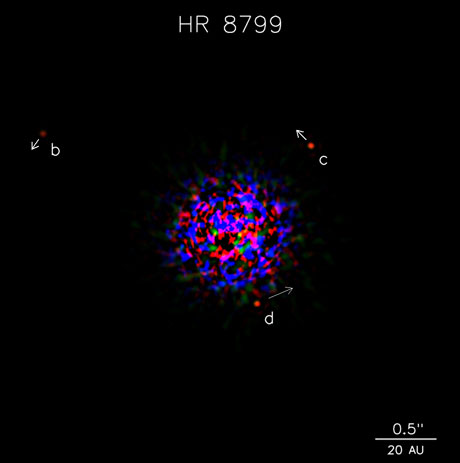Back in 2008, astronomers made a big announcement: for the first time, they had taken pictures of a multi-planet solar system, much like ours, orbiting another star. At the time, the star system, named HR8799 was known to have three planets, but follow-up observations a year later revealed a fourth world.
Astronomers have continued to watch this intriguing star system, and now, using observations from the last 12 years, astrophysicist Jason Wang has put together a time lapse video showing the orbital motions of the four planets.
“Astronomical events either happen too quickly or too slowly to capture in a movie,” said Wang.” But this video shows planets moving on a human time scale. I hope it enables people to enjoy something wondrous.”
The dusty young star HR8799 ch is 140 light years away and about 1.5 times the size of our Sun. Even more intriguing is that HR8799 is visible to the naked eye. It has a magnitude 5.96 and it is located inside the western edge of the great square of Pegasus almost exactly halfway between Scheat and Markab.

The planets were imaged using high-contrast, near-infrared adaptive optics observations with the Keck and Gemini telescopes. In a press release from Northwestern University, Wang said he was instantly fascinated by the system when the news broke in 2008, and has been watching it ever since. He and his colleagues applied for time on the W. M. Keck Observatory, located on the top of Mauna Kea in Hawaii, to observe the system each year.
Using 12 years of imaging data, Wang put together the time lapse video, which shows the entire time period in a condensed 4.5-second time lapse.
“There’s nothing to be gained scientifically from watching the orbiting systems in a time lapse video, but it helps others appreciate what we’re studying,” Wang said. “It can be difficult to explain the nuances of science with words. But showing science in action helps others understand its importance.”

The outer planet orbits inside a dusty disk, much like our own Kuiper belt. Astronomers says it is one of the most massive disks known around any star within 300 light years of Earth. There is an additional debris disk just inside the orbit of the innermost planet – which was the fourth planet to be found. Astronomers say that would be room in the inner system for terrestrial planets. The planet nearest the star takes about 45 Earth years to make one revolution. The farthest planet, on the other hand, takes nearly 500 years to orbit the star.
Wang and his collaborators aren’t finished making observations of this system, and now are examining the light emitted from the star and its planets in order to better understand what they are made of.
“In astrophysics, most of the time we are doing data analysis or testing hypotheses,” he said. “But this is the fun part of science. It inspires awe.”

